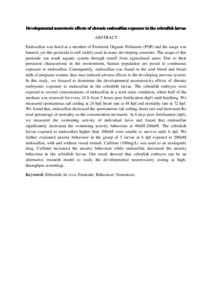Citation
Ramlan, Nurul F. and Mohd Sata, N. S. A. and Wan Ibrahim, Wan Norhamidah
(2016)
Developmental neurotoxic effects of chronic endosulfan exposure in the zebrafish larvae.
In: 14th Meeting of the Asian-Pacific Society for Neurochemistry, 27-30 Aug. 2016, Kuala Lumpur, Malaysia. .
Abstract
Endosulfan was listed as a member of Persistent Organic Pollutants (POP) and the usage was banned, yet this pesticide is still widely used in many developing countries. The usage of this pesticide can reach aquatic system through runoff from agricultural areas. Due to their persistent characteristic in the environment, human population are posed to continuous exposure to endosulfan. Consequently, endosulfan was found in the cord blood and breast milk of pregnant women, thus may induced adverse effects to the developing nervous system. In this study, we focused to determine the developmental neurotoxicity effects of chronic embryonic exposure to endosulfan in the zebrafish larvae. The zebrafish embryos were exposed to several concentrations of endosulfan in a semi static condition, where half of the medium was renewed for every 24 h from 5 hours post fertilization (hpf) until hatching. We measured spontaneous tail coiling at 24 hpf; heart rate at 48 hpf and mortality rate at 72 hpf. We found that, endosulfan decreased the spontaneous tail coiling, heart rate and increased the total percentage of mortality as the concentration increased. At 6 days post fertilization (dpf), we measured the swimming activity of individual larva and found that endosulfan significantly decreased the swimming activity behaviour at 40nM-200nM. The zebrafish larvae exposed to endosulfan higher than 200nM were unable to survive until 6 dpf. We further evaluated anxiety behaviour in the group of 5 larvae at 6 dpf exposed to 200nM endosulfan, with and without visual stimuli. Caffeine (100mg/L) was used as an anxiogenic drug. Caffeine increased the anxiety behaviour while endosulfan decreased the anxiety behaviour in the zebrafish larvae. Our result showed that zebrafish embryos can be an alternative research model to study the developmental neurotoxicity testing at high-throughput screenings.
Download File
![[img]](http://psasir.upm.edu.my/53944/1.hassmallThumbnailVersion/Developmental%20neurotoxic%20effects%20of%20chronic%20endosulfan%20exposure%20in%20the%20zebrafish%20larvae.pdf)  Preview |
|
Text
Developmental neurotoxic effects of chronic endosulfan exposure in the zebrafish larvae.pdf
Download (84kB)
| Preview
|
|
Additional Metadata
Actions (login required)
 |
View Item |

